
This is a complete list of all aerial bombs used by the Imperial Japanese Navy during the Second World War.

This is a complete list of all aerial bombs used by the Imperial Japanese Navy during the Second World War.
The Japanese navy produced a large number of different types of bombs, these were sub-divided into three main categories:
| Bomb type/ mark | Marking scheme | Alternate marking scheme | Purpose | ||||||
|---|---|---|---|---|---|---|---|---|---|
| Nose color / band color | Body color | Tail color | Body band color | Nose color / band color | Body color | Tail color | Body band color | ||
| Land | Green | Grey | Green | Blue | Green / Blue | Grey | Grey | - | Land targets. |
| Ordinary | Green | Grey | Green | - | Green / Blue | Grey | Grey | - | Ship targets. |
| Dummy | Green / Black | White | White | - | - | Dummy bomb | |||
| Practice | Green | Black | White | - | Green / Black | White | White | - | Training. |
| Training | Black overall | - | - | - | - | Training. | |||
| Smoke | Green / Black | Grey | Grey | - | - | - | - | - | For concealing ships. |
| Mark 1 | Green / Yellow | Grey | Yellow | - | - | - | - | - | Chemical gas bomb. |
| Mark 2 | Blue | Grey | Blue | - | Green / Blue | Grey | Grey | - | Anti-submarine. |
| Mark 3 | Silver | Grey | Silver | - | Green / Silver | Grey | Red | - | For air-to-air bombing. |
| Mark 4 | Green / White | Grey | Red | - | - | - | - | - | Rocket bomb. For dive bombing capital ships. |
| Mark 5 | Green / White | Grey | Grey | - | - | - | - | - | Armor-piercing bomb. For use against capital ships. |
| Mark 6 | Green / Red | Grey | Red | - | - | - | - | - | Incendiary. |
| Mark 7 | Green / Purple | Grey | Purple | - | - | - | - | - | Bacillus bomb. |
| Mark 8 | Green / Brown | Grey | Grey | - | - | - | - | - | Anti-shipping skip bomb |
| Mark 19 | - | - | - | - | - | - | - | - | Special bomb used by fighters against bomber formations, redesignated as Mark 28 |
| Mark 21 | Green / Brown | Grey | Grey | - | - | - | - | - | Cluster of small bombs |
| Mark 22 | - | - | - | - | - | - | - | - | Cluster of spike bombs |
| Mark 23 | Green / Brown | Grey | Grey | - | - | - | - | - | Time delay bomb |
| Mark 24 | - | - | - | - | - | - | - | - | Cluster of parachute bombs |
| Mark 25 | - | - | - | - | - | - | - | - | Cluster of wedge bombs |
| Mark 26 | - | - | - | - | - | - | - | - | Unproduced time bomb design. |
| Mark 27 | Green / Silver | Grey/Red | - | - | - | - | - | - | Phosphorus rocket bomb for use against bomber formations. |
| Mark 28 | Green / Brown | Silver | Red | - | - | - | - | - | Rocket type bomb 10 kg high-explosive. |
| Mark 31 | Grey | Grey | Grey | - | - | - | - | - | Land type bomb. Uses an influence fuze. |
| Designation | Type | Weight | Content weight | Content type [1] | Construction | Length | Suspension lugs | Nose | Tail | Fuze | Notes |
|---|---|---|---|---|---|---|---|---|---|---|---|
| No.6 | Land Bomb | 63.5 kg (140 lb) | Picric acid or later Type 98 explosive (mod 1) | Cast steel | Type 2 Model 2 mod 0 or mod 1 | Obsolete during the war. Case is similar to the Type 99 No. 6 Mk. 2 [2] | |||||
| Type 97 No.6 | Land Bomb | 56 kg (124 lb) | 23 kg (50 lb) | Picric acid or Type 98 explosive | Welded and riveted 6.4 mm (1⁄4 in) steel | 100 cm (40 in) | Horizontal navy type | Cast steel | 20 cm (7+7⁄8 in) long sheet steel | A-3(a) | Capable of penetrating 200 mm of reinforced concrete [2] |
| Type 2 No.6 Model 5 | Land Bomb | 60 kg (132 lb) (approx) | Five 7 kg high-explosive bombs with bursting charge | Sheet 1.6 mm (1⁄16 in) steel | 110 cm (42 in) | Horizontal navy type | - | 41 cm (16+1⁄4 in) | A-3 (a) or A-3 (b) | ||
| No.25 | Land Bomb | 250 kg (550 lb) | 150 kg (330 lb) | Type 98 explosive | Welded and riveted 6.4 mm (1⁄4 in) steel | 180 cm (72 in) | Horizontal navy type | Cast steel | 93 cm (36.5 in) long sheet steel | A-3 (a), A-3 (b), C-2 (a), C-1 (a) | Designed in 1938, production ceased early in the Second World War [2] |
| Type 98 No.25 | Land Bomb | 241 kg (532 lb) | 96 kg (211 lb) | Picric acid or Type 98 explosive | Welded and riveted 13 mm (1⁄2 in) steel | 180 cm (72 in) | Horizontal navy type | Cast steel | 83 cm (32.5 in) long sheet steel | A-3 (a), A-3 (b), C-2 (a), C-1 (a) | The bomb was used by Japanese forces at the Battle of Midway. [3] Designed in 1937 adopted in 1938. Capable of penetrating 400 mm of reinforced concrete. [2] |
| No.80 | Land Bomb | 800 kg (1,760 lb) | 382 kg (842 lb) | Picric acid or Type 98 explosive | Welded and riveted 13 mm (1⁄2 in) steel | 290 cm (113 in) | Horizontal, two guide studs, and carrying band | Cast steel | 100 cm (41 in) long 3.2 mm (1⁄8 in) steel | A-1 (c), B-3 (b), A-3 (d) | The bomb was used by Japanese forces at the Battle of Midway. [3] The bomb was designed in 1937 and adopted in 1938, and will penetrate 400 mm of reinforced concrete. [2] |
| Type 99 No.25 | Ordinary Bomb | 250 kg (550 lb) | 60 kg (132 lb) | Type 91 explosive (Trinitroanisol) | One piece of machine forged 19 mm (3⁄4 in) steel | 170 cm (68 in) | Horizontal navy type | - | 71 cm (28 in) long 1.6 mm (1⁄16 in) steel | A-3 (a), A-3 (b), B-2 (a) | Designed in 1938 and adopted in 1939, it is capable of penetrating 50 mm of armor. [2] |
| Type 2 No. 50 Model 1 | Ordinary Bomb | 500 kg (1,100 lb) | 67 kg (148 lb) | Cast blocks of Type 98 explosive | One piece of machine forged steel 25 to 191 mm (1 to 7.5 in) thick | 200 cm (78 in) | Horizontal, two guide studs and suspension band | - | 100 cm (39.5 in) long sheet steel | A-3 (f), B-2 (a) | Teardrop shaped |
| No.80 Model 1 | Ordinary Bomb | 830 kg (1,820 lb) | 350 kg (770 lb) | Type 91 explosive | One piece of machine forged steel 19 mm (0.75 in) thick | 283 cm (111.5 in) | Horizontal, two guide studs, and suspension band | - | 120 cm (49 in) long 4.0 mm (5⁄32 in) thick steel | A-1 (c), A-3 (c), A-3 (d), tail: B-3 (b) | |
| No.3 Model 2 | Ordinary Bomb | 32 kg (70 lb) | ? | Picric acid [4] | One piece of machined steel | 84 cm (33 in) | Horizontal stud on either side of the body | - | 33.7 cm (13.25 in) | A-1 (a), A-3 (a) | Teardrop shaped. Obsolete since the early stages of the war. |
| No.6 Model 2 | Ordinary Bomb | 63 kg (139 lb) | 29 kg (65 lb) | Picric acid | One piece of machined steel | 108 cm (42.5 in) | Horizontal stud on either side of the body | - | 43 cm (17 in) | A-1 (a), A-3 (a) | Teardrop shaped. Production ceased sometime between 1940 and 1941, although they continued to be used. [2] |
| No.25 Model 2 | Ordinary Bomb | 253 kg (557 lb) | 103 kg (228 lb) | Picric acid | One piece of machined steel 16 mm (5⁄8 in) thick | 182 cm (71.5 in) | Horizontal, navy type | - | 69 cm (27 in) | A-3 (a), B-3 (a) | Teardrop shaped. The bomb was used by Japanese forces at the Battle of Midway [3] |
| No.50 Model 2 | Ordinary Bomb | 490 kg (1,080 lb) | 207.5 kg (457.5 lb) | Type 98 explosive | One piece of machined steel 102 to 13 mm (4 to 0.5 in) thick | 230 cm (90 in) | Horizontal, two guide studs and suspension band | - | 84 cm (33 in) | A-3 (a), B-3 (a) | Teardrop shaped |
| Type 99 No.6 Mk 2 | - | 64 kg (140 lb) | 39 kg (85 lb) | Type 98 explosive | Cast nose plug welded to a 4.8 mm (3⁄16 in) thick cylindrical body | 110 cm (42 in) | Horizontal, two guide studs and suspension band | - | 53 cm (21 in) | A-3 (a) | A Mod 1 version of the bomb was also produced with a cylindrical steel anti-ricochet attachment spot welded to the nose giving it a blunt profile. |
| Type 1 No.25 Mk 2 Model 1 | - | 259 kg (572 lb) | 144 kg (317 lb) | Type 98 explosive | Cast nose welded to a 6.4 mm (1⁄4 in) thick cylindrical body | 180 cm (72 in) | Horizontal, two guide studs and suspension band | - | 55 cm (21.5 in) followed by a 38 cm (15 in) plywood extension | A-3 (a), B-3 (a) | A Mod 1 version of the bomb was also produced with a cylindrical steel anti-ricochet attachment spot welded to the nose giving it a blunt profile. |
| Type 99 No.80 Mk 5 | Armor-piercing | 744 kg (1,641 lb) [5] | 30 kg (66 lb) | Type 91 explosive | Single piece of machined forged steel 100 mm (4 in) thick at the nose and 51 mm (2 in) at the tail | 243 cm (95.5 in) | Two guide studs and suspension band | - | 110 cm (43+3⁄8 in) | Two B-2 (b) tail fuzes | Tear drop shaped bomb, eight recesses around the nose could allow the fitting of a wind shield if used as a projectile. Adopted in 1941, basically a converted 40 cm AP shell, capable of penetrating 150 mm of armor. [2] |
| Type 2 No.80 Mk 5 | Armor-piercing | 800 kg (1,760 lb) (approx) | 45 kg (100 lb) (approx) | Type 91 explosive | Single piece of machined forged steel | - | Two B-2 (b) tail fuzes | Intended to supersede the Type 99 No.80. Not produced in large numbers. Designed in 1939, and adopted in 1942. [2] | |||
| Type 3 No.150 Mk 5 | Armor-piercing | 1,500 kg (3,300 lb) (approx) | 91 kg (200 lb) (approx) | Type 91 explosive | Single piece of machined forged steel | - | Two B-2 (b) type tail fuzes | Intended to supersede the Type 99 No.80. Not produced in large numbers. Designed in 1942 and tested in 1944, was in experimental production at the end of the war. [2] | |||
| Type 3 No.25 Mk 8 model 1 | 294 kg (649 lb) (approx) | 119 kg (263 lb) (approx) | Type 97 explosive | Cast steel nose, welded to cylindrical body 13 mm (0.5 in) thick | 170 cm (67 in) | Horizontal type navy | Cast steel | 70 cm (27+3⁄8 in) long | A-3 (a) | ||
| Type 3 No.6 Mk 23 model 1 | 65 kg (143 lb) (approx) | 23 kg (50 lb) (approx) | Type 98 explosive or Picric acid | Cast steel nose, welded and riveted to cylindrical body 6.4 mm (0.25 in) thick | 103.5 cm (40.75 in) | Normal type navy | Cast steel with anti-riccochet cone | 47 cm (18+1⁄2 in) inches long | C-2 (a) | ||
| Type 4 No.25 Mk 29 | Air-to-air bomb | - | - | Explosive with white phosphorus filled steel pellets | Sheet steel with wooden blocks in the nose | - | - | - | - | D-2(a) fuze | Under development at the end of the war to replace No.25 Mk 3 for use against bomber formations, having a larger explosive charge and less incendiary shrapnel. |
| Type 3 No.25 Mk 31 Model 1 | Airburst | 171 kg (378 lb) | 79 kg (175 lb) | Type 98 explosive | Sheet steel cylinder 13 mm (0.5 in) thick with blunt nose | 160 cm (62 in) | Normal navy type | Blunt steel with flange | 81 cm (32 in) | Type 3 electric firing device B-3(a) | Type 3 fuze triggers the bomb at a height of about 7 meters using an electro optical sensor. |
| Type 3 No.80 Mk 31 Model 1 | Airburst | 718 kg (1,584 lb) | 418 kg (922 lb) | Type 98 explosive cast into blocks | Sheet steel cylinder 14 mm (9⁄16 in) thick with blunt nose | 290 cm (113 in) | Two guide studs and a suspension band | Blunt steel with flange | 100 cm (41 in) | Type 3 electric firing device B-3(b) | Type 3 fuze triggers the bomb at a height of about 7 meters using an electro optical sensor. |
| Type 5 No.25 Mk 33 | Airburst | - | - | Explosive with a layer of cylindrical steel fragments | - | - | - | Rounded with plummet fuze holder | - | Plummet electrical fuze with backup Type 15 model 2 fuze | The bomb uses four retarding drogue plates that are opened by an atmospheric pressure fuze to slow descent and release the all-ways plummet fuze, which is suspended by a twenty-meter silk-clad copper to the main bomb. When the plummet fuze touches the ground the bomb is triggered. |

The Japanese produced a number of bombs with rocket motors installed, intended for air-to-air use against bomber formations, or as armor-piercing weapons. Only two saw service, the Type 3 No.25 Mk 4 armor-piercing rocket bomb, and the Type 3 No.6 Mk.27 air-to-air rocket bomb.
| Model | Weight | Description |
|---|---|---|
| Type 3 No.25 Mk 4 Mod 1 | 315 kg | Work on this design began in 1935 and production commenced in 1943. 1.9 meters long, the bomb is an armor-piercing design, with a thick forged steel nose. The bomb attained a speed of about 100 meters per second when launched. The principal drawback was the small 3.5-kilogram bursting charge. |
| Type 5 No.1 Mk 9 Mod 1 | 15 kg (33 lb) | An experimental design, intended for use against surfaced submarines. The bomb carried 1 kilogram (2.2 lb) of explosives, and had a velocity of about 230 meters per second. Experiments were conducted in June 1944, and it was adopted in 1945. Production had started at the end of the war, but it had not been used. Capable of penetrating up to 25 mm of armor. [2] |
| Type 3 No.6 Mk 9 | 84 kg (185 lb) | An experimental design, intended for use against landing craft and small ships. The bomb carried 10 kg (22 lb) of explosives, and had a velocity of about 230 meters per second. |
| Type 3 No.6 Mk 27 | 66 kg (145 lb) | An anti-aircraft rocket that replaced the Type 99 No.3 Mk.3 in air-to-air bombing. It consisted of a large rocket motor with a 2.5 kg (5.5 lb) incendiary shrapnel warhead triggered by a clockwork time fuze with an adjustable delay of up to 10 seconds. The rocket had a maximum velocity of around 270 m/s, and the warhead contained 140 iron pellets with white phosphorus embedded in them, these were scattered in a 60 degree cone when the warhead was triggered. The bomb was designed in January 1944 and adopted in February 1945. [2] |
| Type 3 No.1 Mk 28 | 9.1 kg (20 lb) | An experimental anti-aircraft rocket with a 600 g (1.32 lb) high-explosive warhead. Experiments were conducted in late 1944. This rocket used 2 kg of propellent and had a maximum velocity of 400 m/s. |
~ Type 45 No.44 Mk 6 bomb model 1
Japanese Navy bomb fuzes designation system was unknown to the Allies until after the end of the Second World War. As a result, a designation system was created to describe the fuzes as follows. It consists of a capital letter, a numeral and a lower-case parenthetical letter.
The capital letter designates the fuzes type as follows:
The numeral approximates the order in which the fuzes were captured by the allies. Finally the lower-case letter in parentheses indicates the different but similar designs.
Where possible the original Japanese designation is given.

The Consolidated B-24 Liberator is an American heavy bomber, designed by Consolidated Aircraft of San Diego, California. It was known within the company as the Model 32, and some initial production aircraft were laid down as export models designated as various LB-30s, in the Land Bomber design category.
The Mitsubishi G4M was a twin-engine, land-based medium bomber formerly manufactured by the Mitsubishi Aircraft Company, a part of Mitsubishi Heavy Industries, and operated by the Imperial Japanese Navy from 1940 to 1945. Its official designation is Mitsubishi Navy Type 1 attack bomber and was commonly referred to by Japanese Navy pilots as Hamaki due to the cylindrical shape of its fuselage and its tendency to ignite after a hit. The Allied reporting name was "Betty".

A general-purpose bomb is an air-dropped bomb intended as a compromise between blast damage, penetration, and fragmentation in explosive effect. They are designed to be effective against enemy troops, vehicles, and buildings.
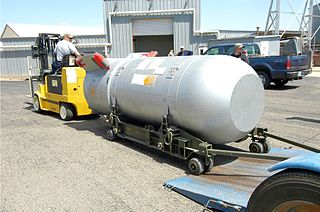
The Mk/B53 was a high-yield bunker buster thermonuclear weapon developed by the United States during the Cold War. Deployed on Strategic Air Command bombers, the B53, with a yield of 9 megatons, was the most powerful weapon in the U.S. nuclear arsenal after the last B41 nuclear bombs were retired in 1976.

The B28, originally Mark 28, was a thermonuclear bomb carried by U.S. tactical fighter bombers, attack aircraft and bomber aircraft. From 1962 to 1972 under the NATO nuclear weapons sharing program, American B28s also equipped six Europe-based Canadian CF-104 squadrons known as the RCAF Nuclear Strike Force. It was also supplied for delivery by UK-based Royal Air Force Valiant and Canberra aircraft assigned to NATO under the command of SACEUR. In addition, certain U.S. Navy carrier based attack aircraft such as the A3D Skywarrior, A4D Skyhawk, and A3J Vigilante were equipped to carry the B28.
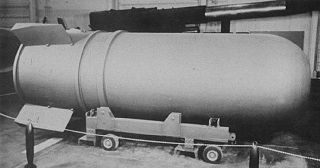
The B-41 was a thermonuclear weapon deployed by the United States Strategic Air Command in the early 1960s. It was the most powerful nuclear bomb ever developed by the United States, with a maximum yield of 25 megatons of TNT. A top secret document, states “The US has stockpiled bombs of 9 MT and 23 MT...” which would likely be referring to the B-41's actual yield(s). The B-41 was the only three-stage thermonuclear weapon fielded by the U.S.

The Mk 20 Rockeye II, CBU-99 Rockeye II, and CBU-100 Rockeye II comprise an American cluster bomb family which are employed primarily in an anti-tank mode against armored vehicles.

The W58 was an American thermonuclear warhead used on the Polaris A-3 submarine-launched ballistic missile. Three W58 warheads were fitted as multiple warheads on each Polaris A-3 missile.

The Mark 39 nuclear bomb and W39 nuclear warhead were versions of an American thermonuclear weapon, which were in service from 1957 to 1966.

The SC 250 was an air-dropped general purpose high-explosive bomb built by Germany during World War II and used extensively during that period. It could be carried by almost all German bomber aircraft, and was used to notable effect by the Junkers Ju 87 Stuka. The bomb's weight was about 250 kg, from which its designation was derived.

The Mark 17 and Mark 24 were the first mass-produced hydrogen bombs deployed by the United States. The two differed in their "primary" stages. They entered service in 1954, and were phased out by 1957.

The 41 cm/45 3rd Year Type naval gun is a 41-centimeter (16.1 in) breech-loading naval gun designed during World War I for the Imperial Japanese Navy. It served as the primary armament in the Nagato-class dreadnoughts completed after the end of the war and in coast defense mountings. Two turrets and their guns were salvaged during the 1970s from the wreck of the Japanese battleship Mutsu and are on display in Japan.

The AB 250-2(Abwurfbehälter) was a cluster bomb used by the Luftwaffe during World War II.
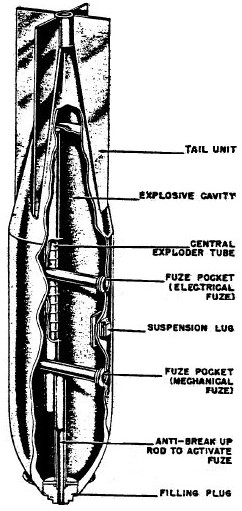
The SB 2500 (Spezialbombe) was a luftmine or aerial mine in English used by the Luftwaffe during World War II.

The SD 50 or thick walled explosive bomb in English was a fragmentation bomb used by the Luftwaffe during World War II.

The SD 70 or thick walled explosive bomb in English was a fragmentation bomb used by the Luftwaffe during World War II.
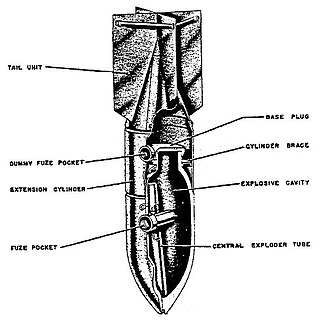
The SD 250 or thick walled explosive bomb in English was a fragmentation bomb used by the Luftwaffe during World War II.
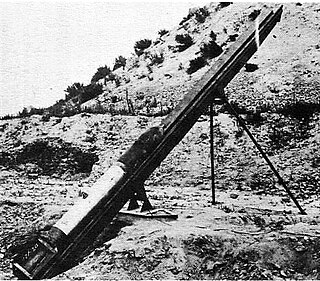
The Type 21 and Type 22 rocket-bombs were rocket artillery systems used by garrison troops of the Imperial Japanese Navy during the late stages of World War II in defense of island bases in the Pacific.